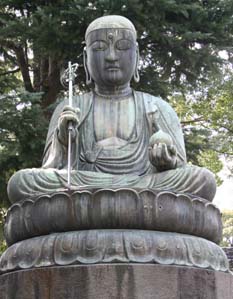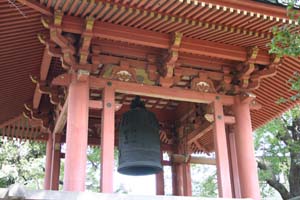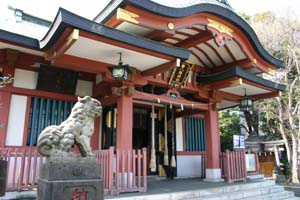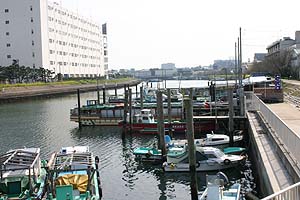

Why Not Visit One Hundred Scenes of Shinagawa? – Walking from Honsen-ji Temple to Katsushima Canal - Part 6 -
Honsen-ji Temple: 3-5-17 Minami-Shinagawa
 Honsen-ji Temple, which is located on the east side of Aomono-Yokocho Station on the Keikyu Line and is said to have been built around the beginning of the 9th century, is associated with Kukai Kobo-Daishi. This is the oldest temple in Shinagawa City, and various things within the temple grounds leave a deep impression of the passage of generations.
Honsen-ji Temple, which is located on the east side of Aomono-Yokocho Station on the Keikyu Line and is said to have been built around the beginning of the 9th century, is associated with Kukai Kobo-Daishi. This is the oldest temple in Shinagawa City, and various things within the temple grounds leave a deep impression of the passage of generations.
In front of the temple gate, which is said to have been built during the Edo Period, there is a large bronze Jizo statue on the left side. Built in 1708, this is one of the Six Edo Jizos – statues of Jizo Bosatsu that were placed at the entrance of each of the six highways that lead to Edo. Enshrined on a stone stand, its sitting height is 2.75 meters. The statue has guarded the safety of travelers on the Tokaido Highway in Shinagawa, which is the entrance to Edo.
In addition, the Daibonsho bell at the back of the temple grounds was built in 1657. This bell was displayed at the Expos held in Paris and Vienna toward the end of the Edo Period (1867), but its whereabouts became unknown on its way back to Japan. Later, it was found to be in the Ariana Museum in Geneva, Switzerland, and was returned to Honsen-ji Temple in 1930. From this incident, the bell became popularly known as “the returnee bell.” Finally, a goodwill exchange program involving the bell became the bridge to peace and goodwill, leading to the tying of a Friendship City Agreement between Shinagawa City and Geneva in 1991.

Kaiun-ji Temple (Sentai Kojin Festival): 3-5-21 Minami-Shinagawa
If you walk towards Omori from Honsen-ji Temple on the Kyu (Old)-Tokaido Highway, you will reach Kaiun-ji Temple, where believers honor the god Kojin of Shinagawa.
The god Sentai Kojin is the god of fire and water, as well as the god of fire prevention in the kitchen. During the grand festivals, held twice a year (in March and November 27 and 28), people make a pilgrimage to the temple, bringing the family Kojin-sama (which is enshrined in their kitchen), wrapping it in a “furoshiki” cloth and hanging it around their neck. They then have it purified in the temple’s sacred fire before receiving a new charm for good fortune prior to going home. Items such as “kojin-matsu” pines, “kama-okoshi” confectionery and “kuzu-mochi” cakes are sold along the pilgrimage path, making the area alive with people and activity.
Samezu Hachiman Jinja Shrine: 1-20-10 Higashi-Oi

If you proceed further along Kyu (Old)-Tokaido Highway until you reach Samezu Station, you will find Samezu Hachiman Jinja Shrine next to the station. In the Edo Period, this area developed as a fisherman’s town that offered seafood to the Edo castle. This shrine had devout believers consisting of Oi fishermen and people from the riverside fish market. Within the shrine grounds, there are Edo Period offering ornaments made of stone, such as the “ishi-doro” stone lanterns and “koma-inu” guardian dogs, many of which were given to the shrine by local fishermen.
Tachiaigawa Riverbank Dock: 2 Higashi-Oi
If you head south from Samezu Hachiman Jinja Shrine and turn left after walking for a while, you will reach Katsushima Canal. If you look toward the ocean from the dock, you can see Yashio Park Town standing in rows beyond Samezu-bashi Bridge (on which Kaigan-dori Avenue runs) and airplanes flying above as they approach Haneda Airport. In spring, flowers blossom along the banks of the canal. With cherry blossoms blooming overhead, many people go to the area to enjoy a leisurely stroll. If you sit by the water, you can enjoy a relaxing time watching water birds.



Copyright (C) 2005 Shinagawa City. All rights reserved.
Shinagawa City Office. 2-1-36, Hiromachi, Shinagawa-ku, Tokyo 140-8715
Tel. 03-3777-1111